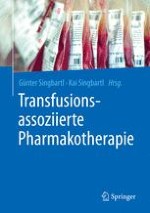Zusammenfassung
Tranexamsäure (TXA) gewinnt mit zunehmend restriktiverer Transfusionsindikation an Bedeutung. Die randomisierte CRASH-2-Studie an > 20.000 Traumapatienten zeigt eine Reduktion der Mortalität um absolute 1,5% infolge Senkung der blutungsbedingten Letalität; die Letalitätsrate sonstiger Ursachen bleibt unverändert. Wichtig ist eine frühzeitige TXA-Gabe binnen 1 h n. d. Trauma. Meta-Analysen über verschiedene operative Fachgebiete hinweg belegen eine Minderung von Blutverlust/Transfusionsbedarf um relative 30–40%. Topische (Orthopädie) und i.-v.-Gabe erweisen sich als gleich wirksam.
Daten von TXA bei pädiatrischen/juvenilen Patienten sind spärlich. Die Ergebnisse deuten auf eine Minderung von Blutverlust und/oder Transfusionsbedarf hin. Der Einsatz von TXA in der Kindertraumatologie wird aus den Daten der CRASH-2-Studie abgeleitet.
Eingeschränkte Nierenfunktion bedingt abhängig vom Kreatinin-Wert eine Dosisreduktion; eingeschränkte Leberfunktion bedarf keiner Dosisanpassung.











